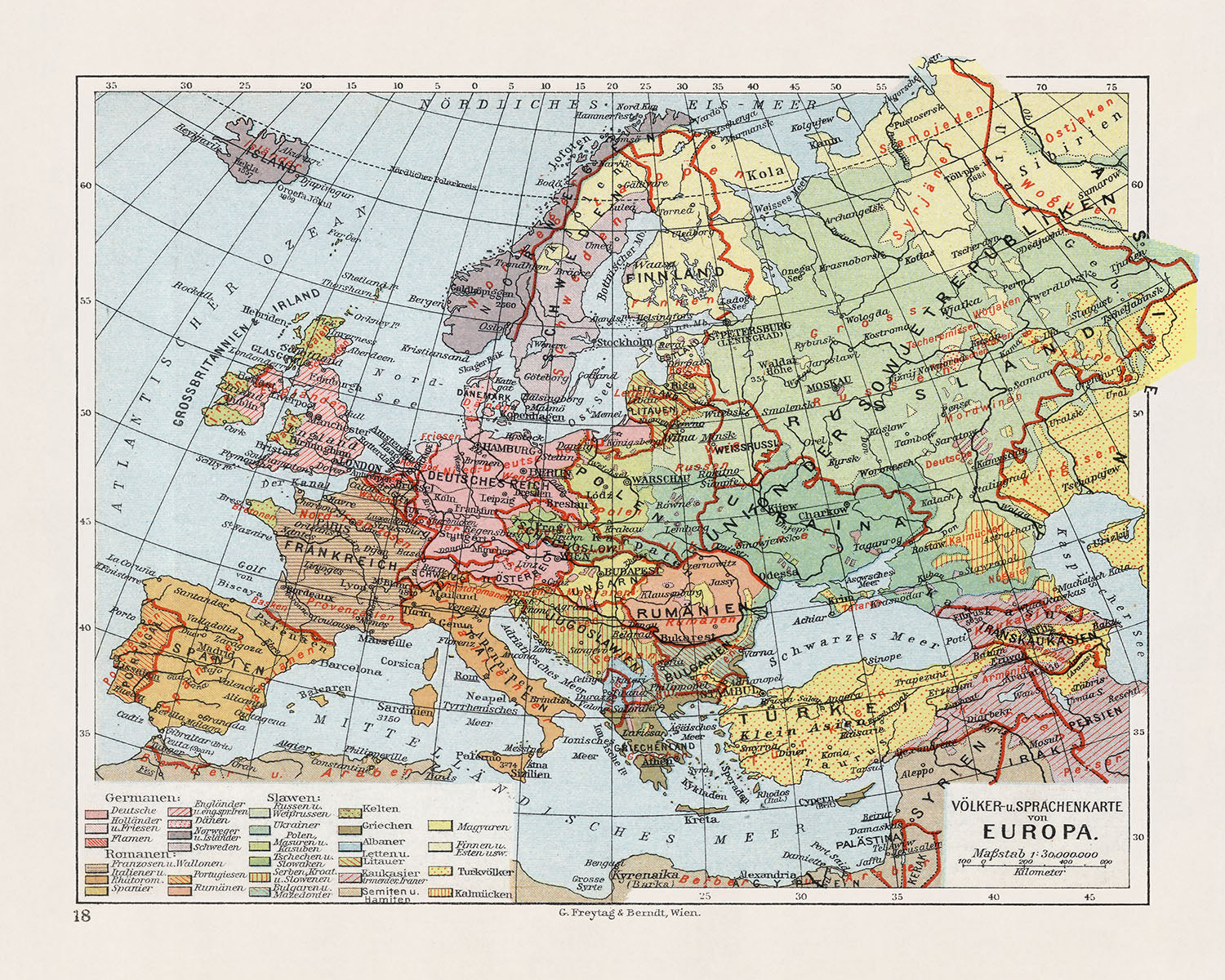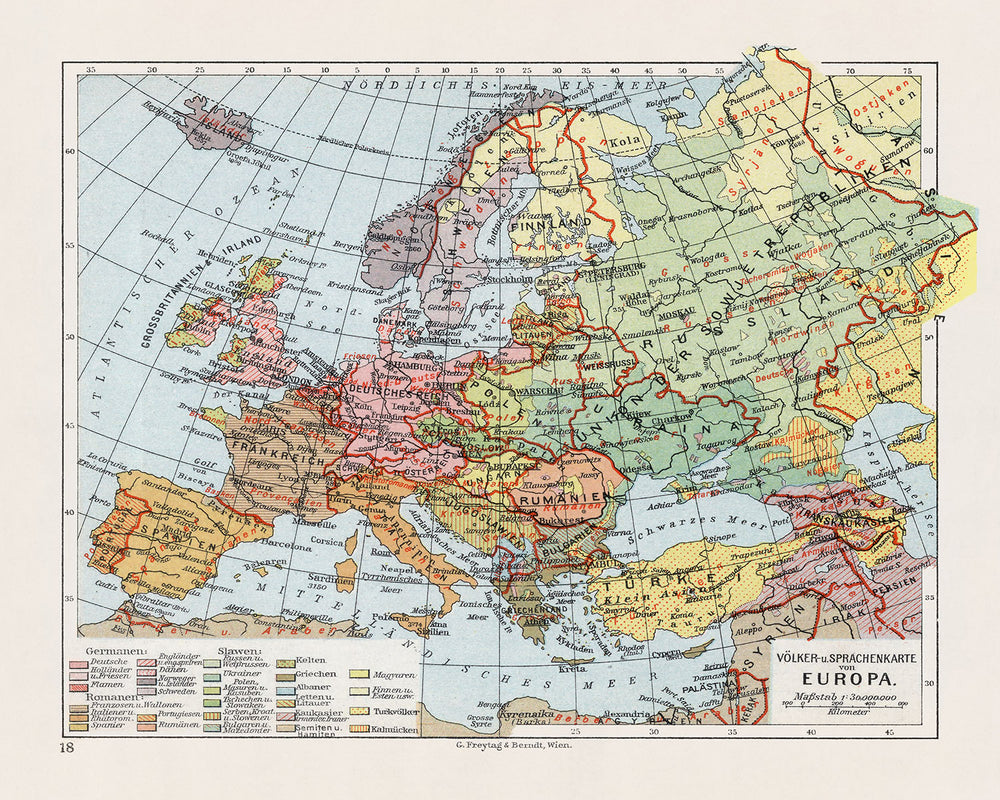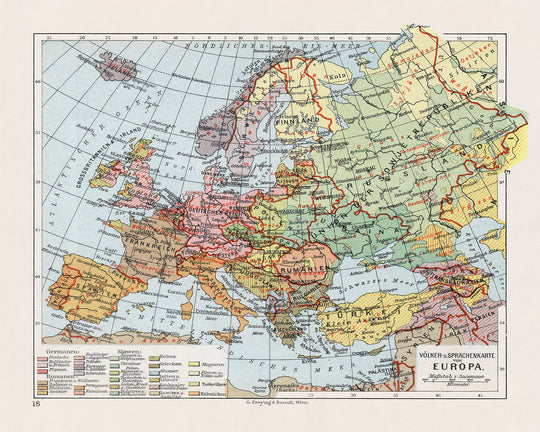- Handmade locally. No import duty or tax
- FREE worldwide delivery
- Love it or your money back (90 days)
- Questions? WhatsApp me any time
Own a piece of history
5,000+ 5 star reviews


Embark on a journey through the linguistic landscape of Europe with the esteemed "Volker- u. Sprachenkarte von Europa," a masterpiece crafted by the distinguished German cartographer and geographer, Anton Leo Hickman. Born in the twilight of the 19th century, Hickman's profound contributions to cartography and geography were not only recognized through his professorship at the University of Vienna but also in his role as the president of the Austrian Geographical Society. This map, created in the pivotal year of 1927, stands as a testament to Hickman's dedication to exploring the intricate tapestry of languages that weave together the continent of Europe. It is not merely a map; it is a historical document that captures the essence of Europe's rich linguistic diversity during a period of significant cultural and political transformation.
The "Volker- u. Sprachenkarte von Europa" is a thematic map par excellence, focusing on the distribution of principal languages across Europe. This unique focus is brought to life through a meticulous color-coded reference system, where demographics and ethnographics are elegantly illustrated, allowing the viewer to traverse the continent's linguistic contours with ease. The observer is guided through Europe's linguistic maze, from the Celtic tongues of the British Isles to the Slavic languages of Eastern Europe, and every linguistic group in between. This map is not just a visual feast; it is a gateway to understanding the complex interplay of languages that define Europe's identity.
Anton Leo Hickman's cartographic prowess is further showcased through the inclusion of detailed insets and illustrations that enrich the map's narrative. These insets provide a deeper understanding of Europe's linguistic diversity, presenting a table of languages, a map highlighting the density of population, and even a depiction of the continent's religious tapestry. Such additions make the "Volker- u. Sprachenkarte von Europa" not just a map, but a comprehensive educational tool, offering insights into the demographic, ethnographic, and religious landscapes of Europe in the early 20th century.
Beyond its thematic focus, the map is a marvel of cartographic design, detailing not only the linguistic but also the physical geography of Europe. It meticulously charts the continent's major bodies of water, from the icy embrace of the Arctic Ocean to the warm waters of the Mediterranean Sea, and its significant mountain ranges, including the majestic Alps and the rugged Urals.
In essence, the "Volker- u. Sprachenkarte von Europa" is more than a map; it is a historical artifact that offers a window into the soul of Europe. Through Anton Leo Hickman's masterful creation, we are invited to explore the continent's linguistic diversity, its demographic and ethnographic nuances, and its rich geographical features. This map is an invaluable resource for anyone fascinated by the geography of Europe, the history of its languages, or the art of cartography itself. It stands as a lasting tribute to Hickman's legacy and a timeless piece of cartographic artistry that continues to inspire and educate.
Countries and regions on this map
- Iceland
- Norway
- Sweden
- Finland
- Russia
- Estonia
- Latvia
- Lithuania
- Poland
- Czechoslovakia
- Germany
- Belgium
- Netherlands
- Denmark
- United Kingdom
- Ireland
- France
- Switzerland
- Austria
- Hungary
- Yugoslavia
- Romania
- Bulgaria
- Greece
- Turkey
- Cyprus
- Spain
- Portugal
- Italy
- Albania
- Malta
Notable Features & Landmarks
- A table of the languages of Europe
- A map of the density of population in Europe
- A map of the religions of Europe
- The Atlantic Ocean
- The Arctic Ocean
- The Baltic Sea
- The Black Sea
- The Caspian Sea
- The Mediterranean Sea
- The North Sea
- The Norwegian Sea
- The White Sea
- The Alps
- The Carpathian Mountains
- The Caucasus Mountains
- The Pyrenees
- The Scandinavian Mountains
- The Urals
- The English Channel
- The Strait of Gibraltar
- The North Cape
- The borders of the European countries
- The capital cities of the European countries
- The major rivers of Europe
- The major lakes of Europe
Historical and design context
- The map is titled "Volker- u. Sprachenkarte von Europa".
- Shows the geographic distribution of principal languages in Europe.
- Includes a color-coded reference.
- The dominant ethnography or demography of an area appears to be written in a large red font, for example 'ENGLANDER' and 'KATALANEN' (Catalonian).
- Made in 1927 by Anton Leo Hickman, a German cartographer and geographer.
- Hickman was a professor of geography at the University of Vienna and president of the Austrian Geographical Society.
- The map is an example of Hickman's work and a thematic map, focusing on the distribution of a particular theme or topic, in this case, language.
- It is a useful tool for understanding the linguistic diversity of Europe and can also be used to study the history of languages in Europe.
- The map is a valuable resource for anyone interested in the geography of Europe.
Please double check the images to make sure that a specific town or place is shown on this map. You can also get in touch and ask us to check the map for you.
This map looks great at every size, but I always recommend going for a larger size if you have space. That way you can easily make out all of the details.
This map looks amazing at sizes all the way up to 40in (100cm). If you are looking for a larger map, please get in touch.
The model in the listing images is holding the 16x20in (40x50cm) version of this map.
The fifth listing image shows an example of my map personalisation service.
If you’re looking for something slightly different, check out my collection of the best old maps to see if something else catches your eye.
Please contact me to check if a certain location, landmark or feature is shown on this map.
This would make a wonderful birthday, Christmas, Father's Day, work leaving, anniversary or housewarming gift for someone from the areas covered by this map.
This map is available as a giclée print on acid free archival matte paper, or you can buy it framed. The frame is a nice, simple black frame that suits most aesthetics. Please get in touch if you'd like a different frame colour or material. My frames are glazed with super-clear museum-grade acrylic (perspex/acrylite), which is significantly less reflective than glass, safer, and will always arrive in perfect condition.
This map is also available as a float framed canvas, sometimes known as a shadow gap framed canvas or canvas floater. The map is printed on artist's cotton canvas and then stretched over a handmade box frame. We then "float" the canvas inside a wooden frame, which is available in a range of colours (black, dark brown, oak, antique gold and white). This is a wonderful way to present a map without glazing in front. See some examples of float framed canvas maps and explore the differences between my different finishes.
For something truly unique, this map is also available in "Unique 3D", our trademarked process that dramatically transforms the map so that it has a wonderful sense of depth. We combine the original map with detailed topography and elevation data, so that mountains and the terrain really "pop". For more info and examples of 3D maps, check my Unique 3D page.
For most orders, delivery time is about 3 working days. Personalised and customised products take longer, as I have to do the personalisation and send it to you for approval, which usually takes 1 or 2 days.
Please note that very large framed orders usually take longer to make and deliver.
If you need your order to arrive by a certain date, please contact me before you order so that we can find the best way of making sure you get your order in time.
I print and frame maps and artwork in 23 countries around the world. This means your order will be made locally, which cuts down on delivery time and ensures that it won't be damaged during delivery. You'll never pay customs or import duty, and we'll put less CO2 into the air.
All of my maps and art prints are well packaged and sent in a rugged tube if unframed, or surrounded by foam if framed.
I try to send out all orders within 1 or 2 days of receiving your order, though some products (like face masks, mugs and tote bags) can take longer to make.
If you select Express Delivery at checkout your order we will prioritise your order and send it out by 1-day courier (Fedex, DHL, UPS, Parcelforce).
Next Day delivery is also available in some countries (US, UK, Singapore, UAE) but please try to order early in the day so that we can get it sent out on time.
My standard frame is a gallery style black ash hardwood frame. It is simple and quite modern looking. My standard frame is around 20mm (0.8in) wide.
I use super-clear acrylic (perspex/acrylite) for the frame glass. It's lighter and safer than glass - and it looks better, as the reflectivity is lower.
Six standard frame colours are available for free (black, dark brown, dark grey, oak, white and antique gold). Custom framing and mounting/matting is available if you're looking for something else.
Most maps, art and illustrations are also available as a framed canvas. We use matte (not shiny) cotton canvas, stretch it over a sustainably sourced box wood frame, and then 'float' the piece within a wood frame. The end result is quite beautiful, and there's no glazing to get in the way.
All frames are provided "ready to hang", with either a string or brackets on the back. Very large frames will have heavy duty hanging plates and/or a mounting baton. If you have any questions, please get in touch.
See some examples of my framed maps and framed canvas maps.
Alternatively, I can also supply old maps and artwork on canvas, foam board, cotton rag and other materials.
If you want to frame your map or artwork yourself, please read my size guide first.
My maps are extremely high quality reproductions of original maps.
I source original, rare maps from libraries, auction houses and private collections around the world, restore them at my London workshop, and then use specialist giclée inks and printers to create beautiful maps that look even better than the original.
My maps are printed on acid-free archival matte (not glossy) paper that feels very high quality and almost like card. In technical terms the paper weight/thickness is 10mil/200gsm. It's perfect for framing.
I print with Epson ultrachrome giclée UV fade resistant pigment inks - some of the best inks you can find.
I can also make maps on canvas, cotton rag and other exotic materials.
Learn more about The Unique Maps Co.
Map personalisation
If you're looking for the perfect anniversary or housewarming gift, I can personalise your map to make it truly unique. For example, I can add a short message, or highlight an important location, or add your family's coat of arms.
The options are almost infinite. Please see my map personalisation page for some wonderful examples of what's possible.
To order a personalised map, select "personalise your map" before adding it to your basket.
Get in touch if you're looking for more complex customisations and personalisations.
Map ageing
I have been asked hundreds of times over the years by customers if they could buy a map that looks even older.
Well, now you can, by selecting Aged before you add a map to your basket.
All the product photos you see on this page show the map in its Original form. This is what the map looks like today.
If you select Aged, I will age your map by hand, using a special and unique process developed through years of studying old maps, talking to researchers to understand the chemistry of aging paper, and of course... lots of practice!
If you're unsure, stick to the Original colour of the map. If you want something a bit darker and older looking, go for Aged.
If you are not happy with your order for any reason, contact me and I'll get it fixed ASAP, free of charge. Please see my returns and refund policy for more information.
I am very confident you will like your restored map or art print. I have been doing this since 1984. I'm a 5-star Etsy seller. I have sold tens of thousands of maps and art prints and have over 5,000 real 5-star reviews. My work has been featured in interior design magazines, on the BBC, and on the walls of dozens of 5-star hotels.
I use a unique process to restore maps and artwork that is massively time consuming and labour intensive. Hunting down the original maps and illustrations can take months. I use state of the art and eye-wateringly expensive technology to scan and restore them. As a result, I guarantee my maps and art prints are a cut above the rest. I stand by my products and will always make sure you're 100% happy with what you receive.
Almost all of my maps and art prints look amazing at large sizes (200cm, 6.5ft+) and I can frame and deliver them to you as well, via special oversized courier. Contact me to discuss your specific needs.
Or try searching for something!















































